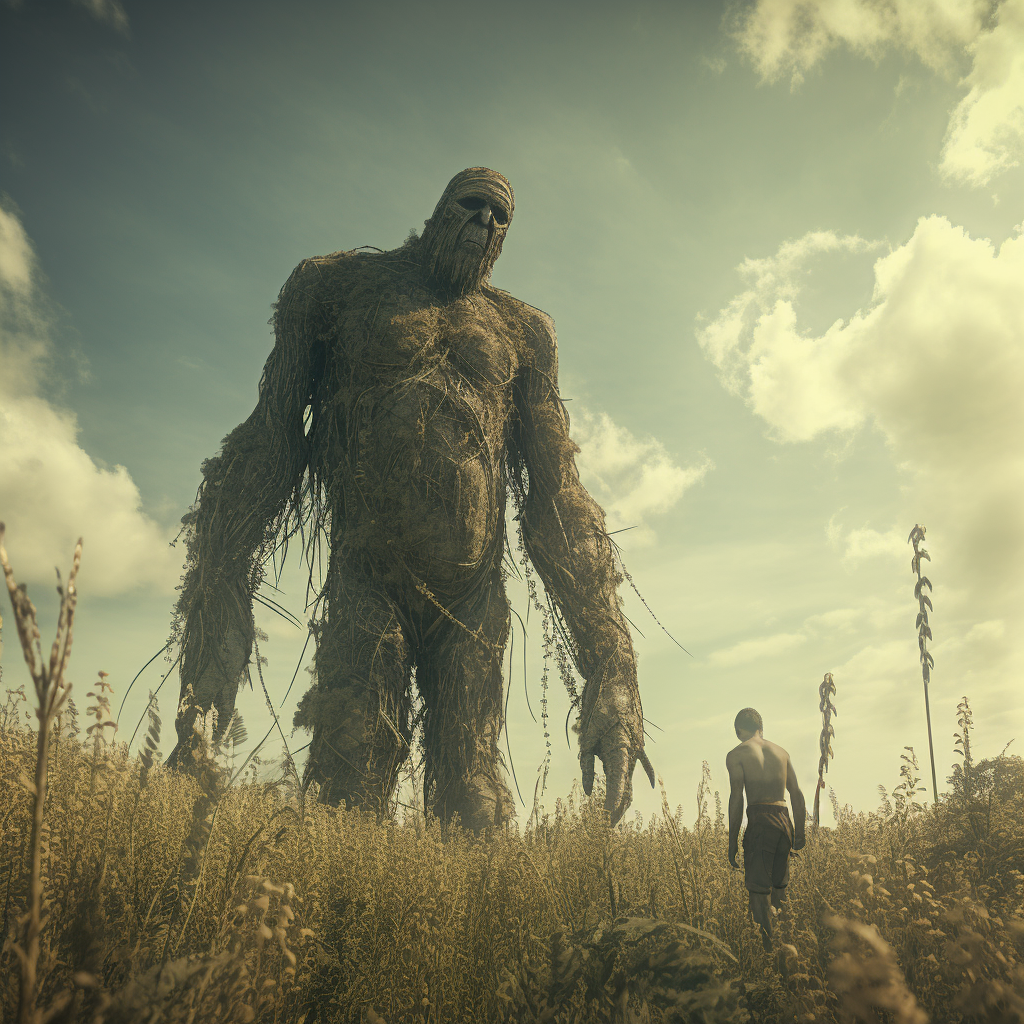The Giants And Their Legendary Past

Table of Contents
Origins and Myths of the Giants
Giants, those colossal beings of myth and legend, hold a prominent place in the folklore of numerous cultures worldwide. Their origins and roles vary significantly, reflecting the unique beliefs and worldviews of different societies. Understanding their diverse origins is key to appreciating the richness of the Giants' Legendary Past.
Giants in Greek Mythology
Greek mythology is replete with giants, often depicted as primordial beings associated with chaos and the untamed forces of nature. The Titans, for example, represent a powerful generation of giants who waged war against the Olympian gods. This titanic struggle is a cornerstone of Greek cosmology, shaping the very structure of their pantheon and the world order.
- Typhoeus: A monstrous giant, son of Gaia (Earth) and Tartarus (the abyss), who challenged Zeus for supremacy.
- Atlas: Condemned by Zeus to bear the heavens on his shoulders, a symbol of immense strength and burden.
- Cronus: A Titan who devoured his own children to prevent a prophecy of his downfall.
Giants in Norse Mythology
Norse mythology features the Jotunn, a race of giants inhabiting Jötunheimr, a realm distinct from Asgard, the home of the Aesir gods. The relationship between the Aesir and the Jotunn is often characterized by conflict and uneasy alliances, reflecting the inherent tensions between order and chaos in Norse cosmology. These giants often possess immense power and magical abilities, playing pivotal roles in shaping the fate of the gods and the world.
- Ymir: The primordial giant from whose body the world was created according to Norse creation myths.
- Loki: While not always strictly a giant, Loki, the trickster god, possessed Jotunn ancestry and often sided with the giants against the Aesir.
Giants in Other Cultures
Giants are not solely confined to Greek and Norse mythology. Their presence extends across a vast spectrum of cultures, each offering unique interpretations of these colossal figures. These variations highlight the universality of the giant archetype and its capacity to embody different cultural values and anxieties.
- Fomorians (Celtic Mythology): A race of monstrous giants associated with chaos and darkness.
- Baba Yaga (Slavic Folklore): A powerful, often ambiguous figure, sometimes benevolent, sometimes malevolent.
- Nephilim (Biblical Texts): Offspring of fallen angels and human women, often described as giants of immense strength.
Powers and Abilities of Legendary Giants
The legendary giants are rarely just large; they are often imbued with supernatural abilities, exceeding the limitations of ordinary mortals. These powers contribute significantly to their captivating and fearsome presence in the myths and legends that shape their past.
Physical Prowess
The defining characteristic of giants is their immense physical strength and size. Myths frequently portray them as capable of moving mountains, wielding colossal weapons, and engaging in feats of incredible power that defy human comprehension. This superhuman physicality underscores their dominance over the natural world and their potential for both creation and destruction.
- Atlas holding the heavens: A testament to their unmatched strength and endurance.
- Giants building structures: Many myths describe giants constructing impressive monuments and structures.
Magical Abilities
Beyond their physical might, many giants in folklore possess magical abilities, enhancing their power and influence. These magical skills range from sorcery and shape-shifting to the control of natural elements, furthering their mystical and often terrifying nature.
- Giants' control over storms and weather: Many giants are linked to powerful weather phenomena.
- Giants using magic to create illusions and enchantments: This showcases their control over the mystical realm.
Connection to Nature
Giants are frequently intertwined with the natural world, often depicted as guardians or embodiments of specific landscapes, like mountains, forests, or storms. This close association underscores their powerful connection to the untamed forces of nature and their role within the cosmic order.
- Giants inhabiting mountains and caves: Often seen as protectors or rulers of these natural habitats.
- Giants controlling natural elements like fire, water, or earth: This strengthens their tie to the environment.
The Giants' Enduring Legacy
The impact of giants’ stories extends far beyond their initial appearance in ancient myths. Their image continues to shape our cultural landscape, influencing artistic expressions and modern narratives.
Giants in Literature and Art
Giants have inspired countless works of art and literature throughout history. Their imposing figures and dramatic tales have provided endless inspiration for artists and writers, shaping our collective perception and interpretations of these powerful beings.
- The Colossus of Rhodes: A gigantic bronze statue, a testament to the enduring appeal of gigantic figures.
- John Milton's Paradise Lost: Features giants prominently, showcasing their enduring relevance in major literary works.
Giants in Modern Culture
The legacy of the Giants' Legendary Past persists in contemporary culture, continuing to influence our modern entertainment and imagination. Their image is adapted and reinterpreted in various ways, often reflecting modern anxieties and aspirations.
- Giant monsters in movies and video games: Popular culture utilizes the giant archetype extensively.
- Anthropomorphic giants in children's literature: This reflects the adaptation of the archetype to different audiences.
Symbolic Meaning of Giants
The enduring appeal of giants lies not just in their impressive physicality but also in their symbolic significance. Their presence often represents raw power, untamed nature, primordial chaos, or the mysteries of the unknown, sparking endless debate and interpretation.
- Giants as symbols of power and dominance: Their size often mirrors their power.
- Giants as representations of the unknown and the unpredictable: Their mysterious nature often frightens and intrigues.
Conclusion
From the primordial chaos of the Titans to the formidable Jotunn of Norse mythology, the Giants' Legendary Past is a rich and complex tapestry woven from diverse cultures and enduring myths. Their superhuman abilities, connections to nature, and lasting impact on our collective imagination continue to fascinate and inspire. Their presence in our literature, art, and modern media demonstrates the persistent power of these legendary figures and their timeless allure.
Delve deeper into the fascinating world of giants! Explore further research on the Giants' Legendary Past and discover the captivating stories that have shaped our understanding of mythology and folklore. Share your favorite giant myths and legends in the comments below!

Featured Posts
-
 Effektivere Waldbrandbekaempfung Sachsenforst Testet Innovative Sensoren In Der Saechsischen Schweiz
May 14, 2025
Effektivere Waldbrandbekaempfung Sachsenforst Testet Innovative Sensoren In Der Saechsischen Schweiz
May 14, 2025 -
 Experience John Barrys From York With Love At Your Local Everyman
May 14, 2025
Experience John Barrys From York With Love At Your Local Everyman
May 14, 2025 -
 Maya Jamas Simple Skincare A Face Mask For A Radiant Glow
May 14, 2025
Maya Jamas Simple Skincare A Face Mask For A Radiant Glow
May 14, 2025 -
 Remembering A Giants Legend His Influence Today
May 14, 2025
Remembering A Giants Legend His Influence Today
May 14, 2025 -
 Man Utd Among Six Premier League Teams In Race For Sunderland Player
May 14, 2025
Man Utd Among Six Premier League Teams In Race For Sunderland Player
May 14, 2025
Latest Posts
-
 Spanish Television Ignites Debate Should Israel Be In Eurovision
May 14, 2025
Spanish Television Ignites Debate Should Israel Be In Eurovision
May 14, 2025 -
 Dont Hate The Playaz Respect And Competition In Hip Hop
May 14, 2025
Dont Hate The Playaz Respect And Competition In Hip Hop
May 14, 2025 -
 Israels Eurovision Bid Faces Scrutiny From Spanish Broadcaster
May 14, 2025
Israels Eurovision Bid Faces Scrutiny From Spanish Broadcaster
May 14, 2025 -
 Dont Hate The Playaz A Cultural Analysis
May 14, 2025
Dont Hate The Playaz A Cultural Analysis
May 14, 2025 -
 Eurovision 2024 Spanish Media Spars Over Israels Song Contest Entry
May 14, 2025
Eurovision 2024 Spanish Media Spars Over Israels Song Contest Entry
May 14, 2025
